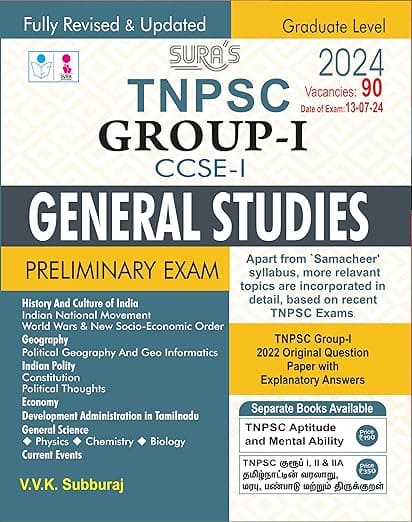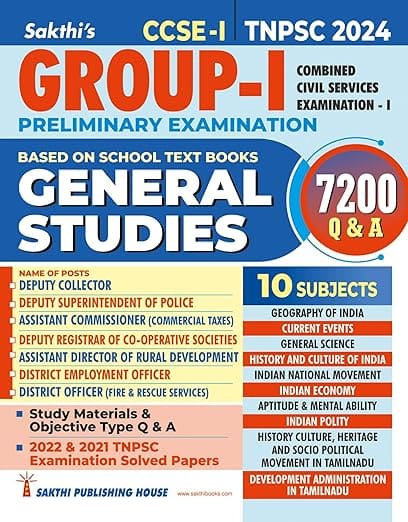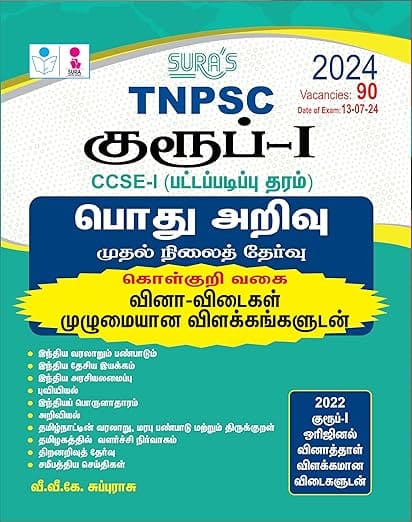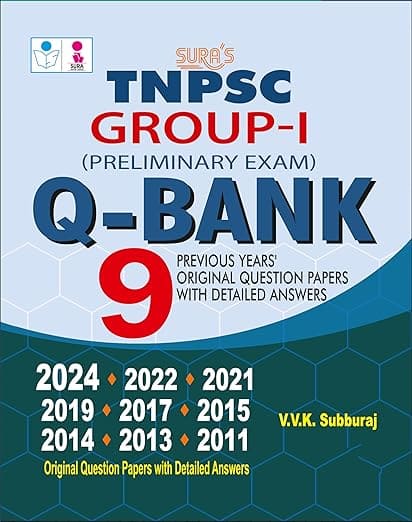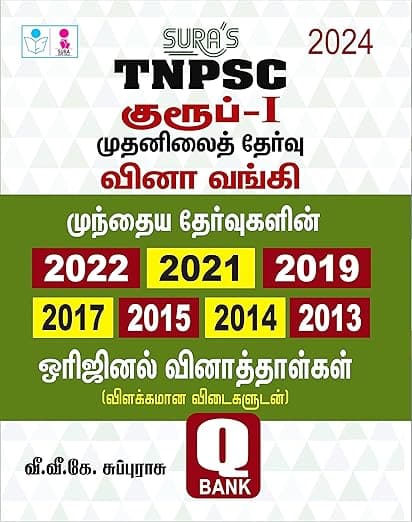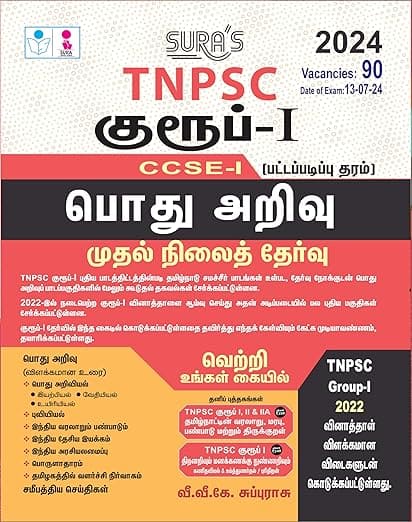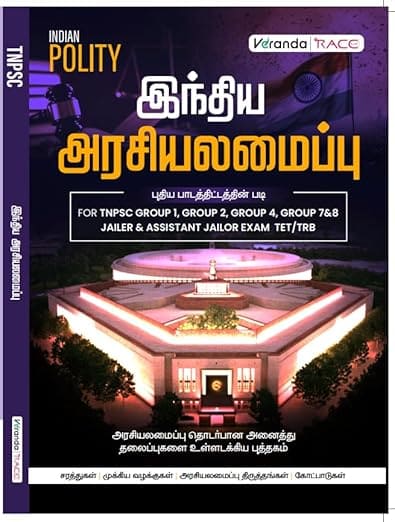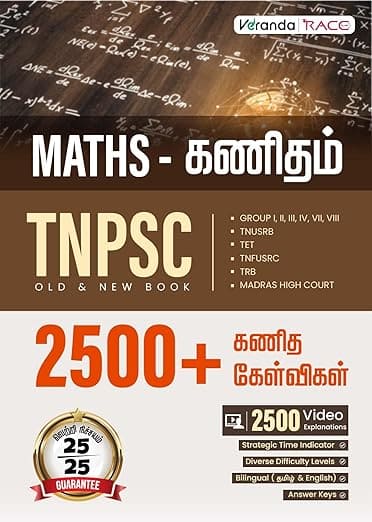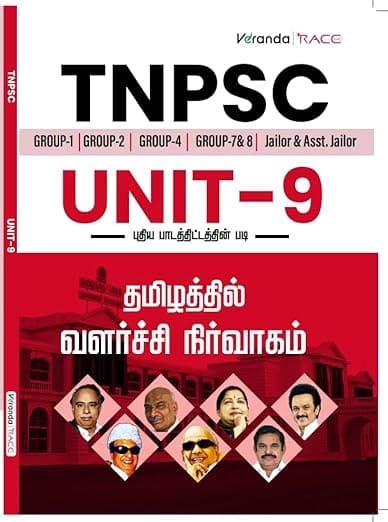English : Term 3 Unit 2 : Creativity Around Me
UNIT 2
Creativity Around Me
I love to paint. Do you?
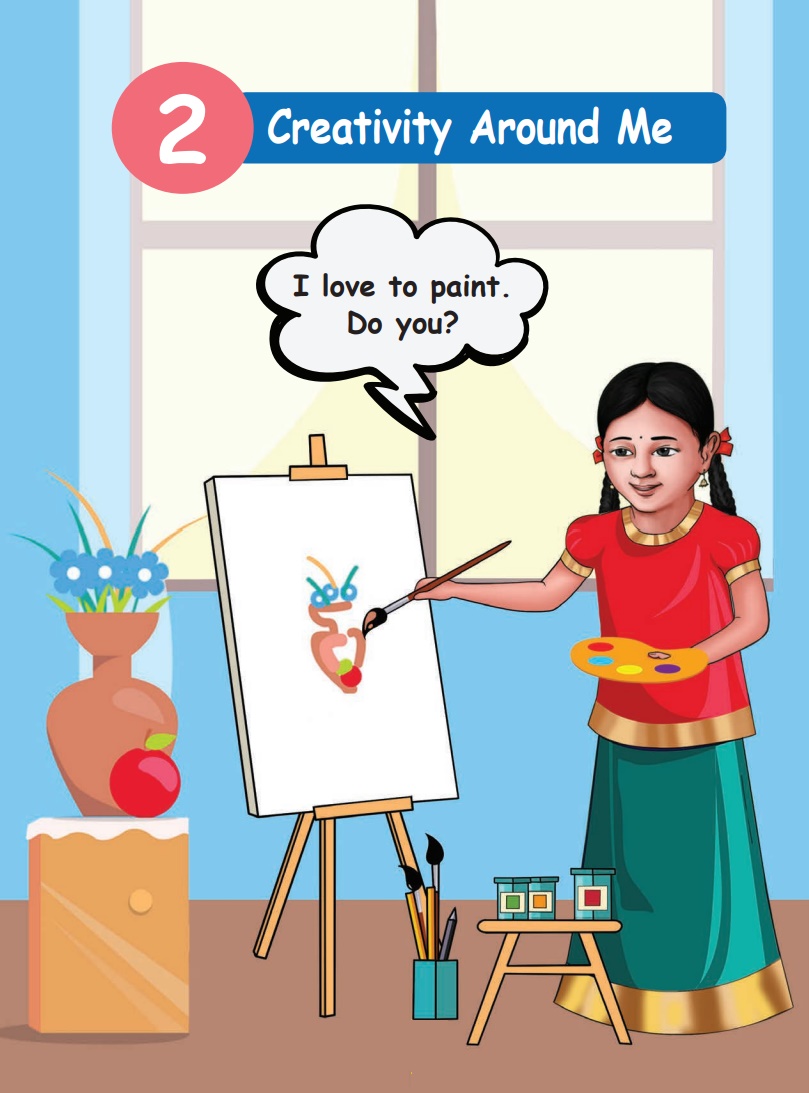
MY LITTLE PICTIONARY
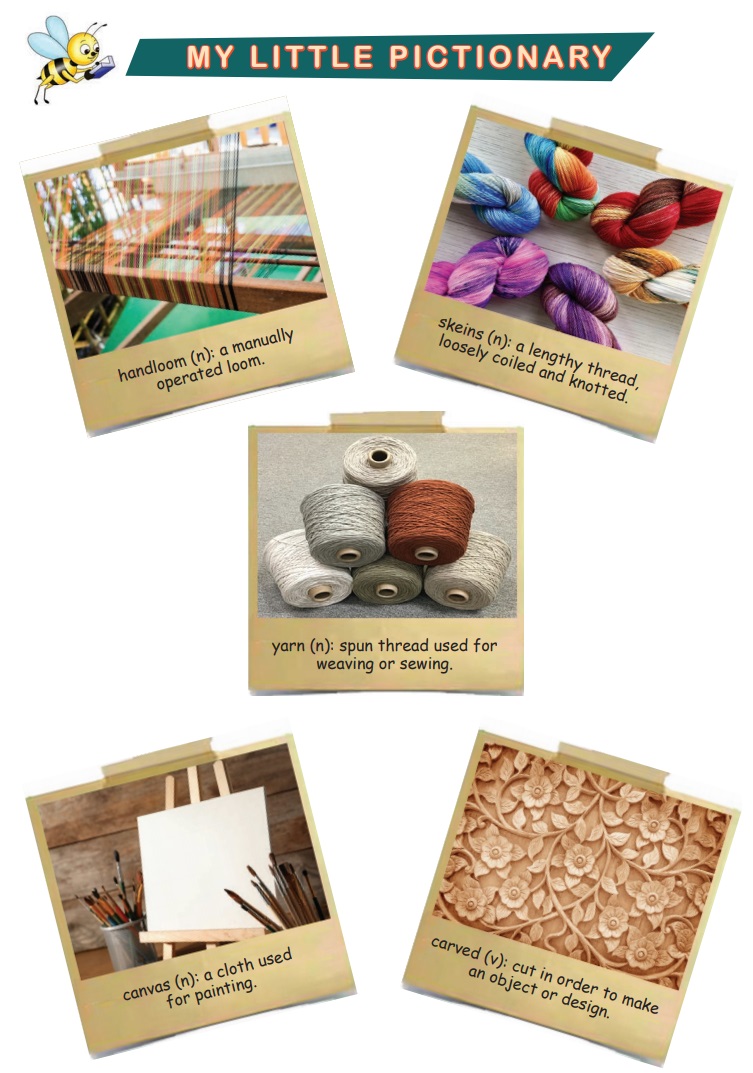
LET US LEARN
Bala Spins Magic
It was a hot afternoon in the quiet village of Periya Negamam, near Pollachi. The village has tiled roof houses. Bala and his family lived in one such house. He sat under a tree, waiting for his father. He was going with Appa on a long journey.
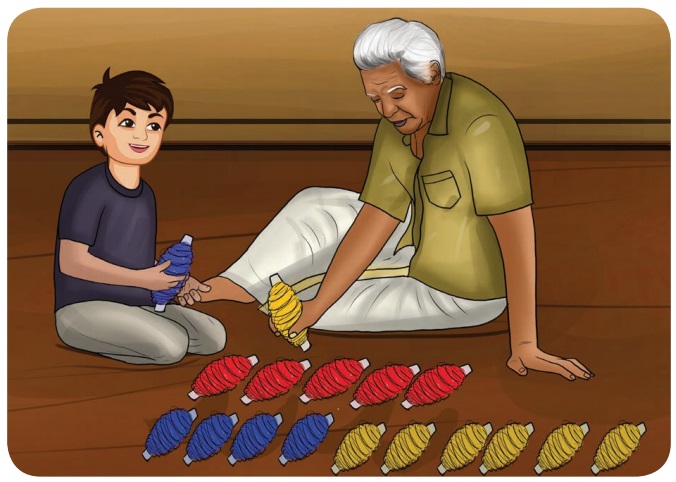
A fly buzzed near his ear. The pleasant shade of the tree along with the steady click-clack of the handlooms from the huts nearby made him feel sleepy. He wondered if he could catch some sleep before Appa arrived.
Bala, like most of the children in his village, went to school but always wanted to learn more about things related to their family profession weaving. Veera thatha had made math easy for Bala by using skeins of yarn in bunches, sometimes adding all the blue skeins and subtracting the yellow skeins and then doubling the reds and taking away the greens. Bala thought, “This was a fun way to learn Math!”
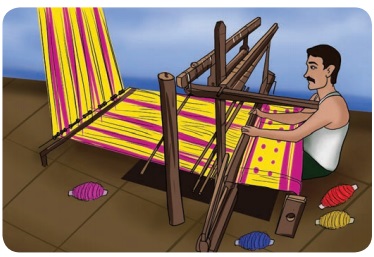
Bala’s family came from a long line of handloom weavers. They had perfected the art of drawing, dying, warping and weaving the yarn. But it was a hard work. Unless Bala, his mother, father, sisters and cousins helped with the work, Appa could never weave the lengths, he needed.
Bala would often see Appa and Amma weave bundles of cotton into beautiful sarees with checks or patterns. He hoped to weave someday. He would also help Amma and sisters, roll, press and pack the sarees.
Bala wondered, “Amma, why you never wear the beautiful sarees we make?”
Amma said, “I can do that only if we become a very rich family.”
Bala woke up suddenly as he felt someone tap his head.
“Are you ready to go?”, asked Appa.
“Yes Appa.”, said Bala and started counting the bags around him.
Bala was going with Appa to Chennai to help him carry the sarees. Appa said, “We will get a better price for the sarees, if we sell directly to ladies in Chennai than to traders in Pollachi or Coimbatore.”
They walked to the bus stop and had to wait for nearly one hour for the bus. It took them to Coimbatore junction, and from there they left in a train to Chennai. The train journey was not very comfortable. “Don’t worry Bala. Our return will be more comfortable as we will be able to reserve tickets,” said Appa. They reached Chennai and went to Purasaiwalkam, where Appa’s friend lived.
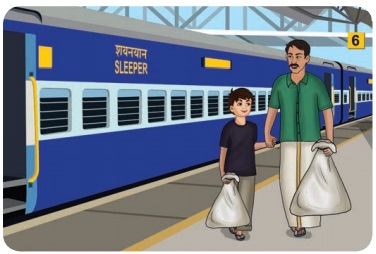
The next morning Appa was ready with places to visit to sell the sarees. Bala could not read the big instructions in the sign board and hence held his father tightly.
Soon, they reached a big house after what seemed like many hours. The guard at the door let them in. They sat in a big hall and unpacked the sarees.
A young boy saw them and called out saying, “Mom! There’s a man with two bundles to meet you.”
Appa was showing the saree to the aunty and trying to sell it to her. He made each saree sound special and unique. He even draped the saree over him to show the design. Soon, the other boy asked, “Mom, can I ask the boy to come and play with me?”
“What is your name?” asked the boy.
“Periya Negamam Balakumaran,” said Bala. “What’s yours?”
“Nithin,” said the boy.
Nithin’s room was full of toys. Nithin let Bala play with all the toys. Most toys had some electrical control. Since Bala’s home does not have electricity, he did not know to play with most of the toys.
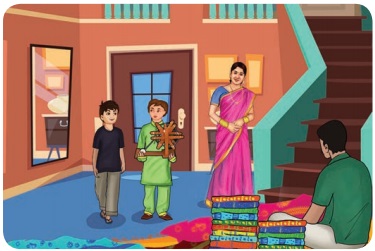
In one corner, Bala saw a spinning wheel. Now, this was a toy he knew to play with!
“Do you know what to do with it? I don’t know to play with it,” said Nithin.
“This is Rattai. Do you have some cotton?”, asked Bala. Nithin did not have.
Bala dug Appa’s bag to get some cotton. Bala took the cotton fluff and attached it to the spinning wheel, and turned the wheel all the while.
“You can do magic!”, shouted Nithin, “Can you teach me?”
“Not like that. Do it this way. Here, hold this. Spin this!”, said Bala.
Bala had a wide smile across his face. Nithin struggled but soon learnt to spin.
Soon they stepped out. Appa had sold many sarees to the aunty.
“Mom! Mom! He taught me magic,” said Nithin.
Aunty laughed and said, “Well naturally, his father is a magician too. A weaving magician.”
“Yes! I will tell all my friends in school that a magician from Periya Negamam taught me this magic.”
Glossary
weave: form by interlacing long threads.
substract: take away from another to calculate difference.
warp: twist out of shape.
uncomfortable: causing physical pain.
drape: arrange loosely
LET US UNDERSTAND
A. Fill in the blanks.
1. Appa weaves beautiful sarees with checks and patterns.
2. Veera thatha had made Math easy for Bala.
3. Nithin had many electrical toys.
4. Bala’s home doesn’t have electricity.
5. Nithin’s mom said that Bala’s father is a weaving magician.
B. Answer the questions.
1. What did Bala want to learn?
Bala wanted to learn things related to weaving.
2. How did Bala help Amma and sisters?
Bala helped Amma and sisters to roll, press and pack the sarees.
3. Why did Bala go to Chennai with his father?
Bala went to Chennai with his father to help him carry the sarees.
4. What did Bala teach Nithin?
Bala taught Nithin to spin using a spinning wheel.
5. What would you like to learn in school? why?
I would like to learn drawing because I want to become an artist.
LET US BUILD
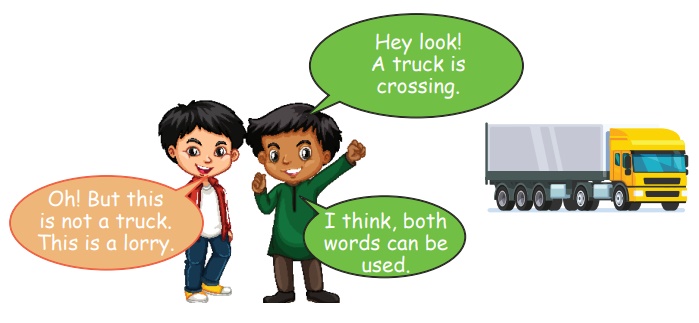
Hey look! A truck is crossing.
Oh! But this is not a truck. This is a lorry.
I think, both words can be used.
Some words are used to indicate same thing.
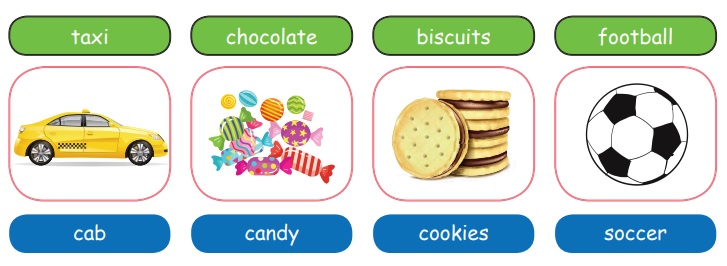
Let us learn more words with similar meanings.
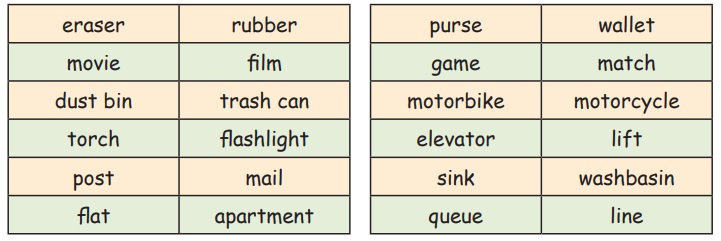
A. Let us learn a few more words by joining the dots.
Join the dots and fill the table below.
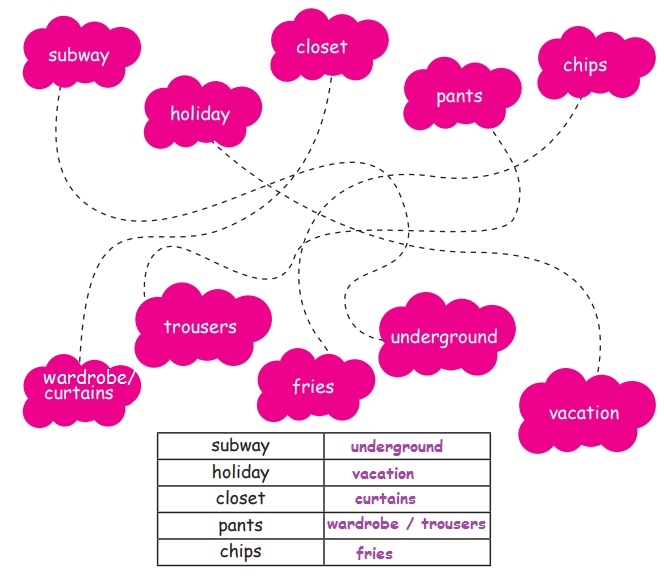
B. Write the words with same meaning.
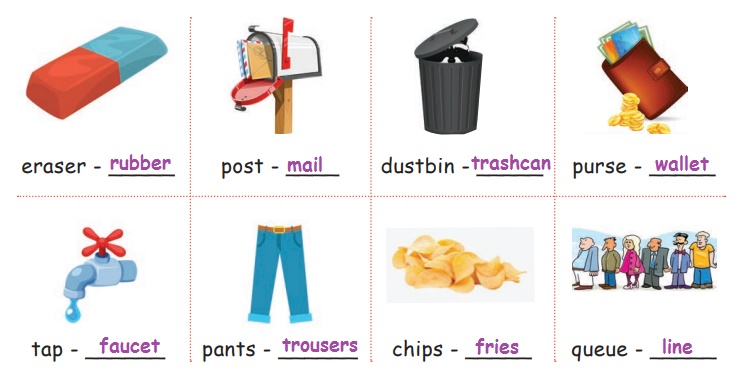
eraser – rubber ; post – mail; dustbin – trashcan; purse – wallet;
tap – faucet; pants – trousers; chips – fries; queue – line;
LET US SING
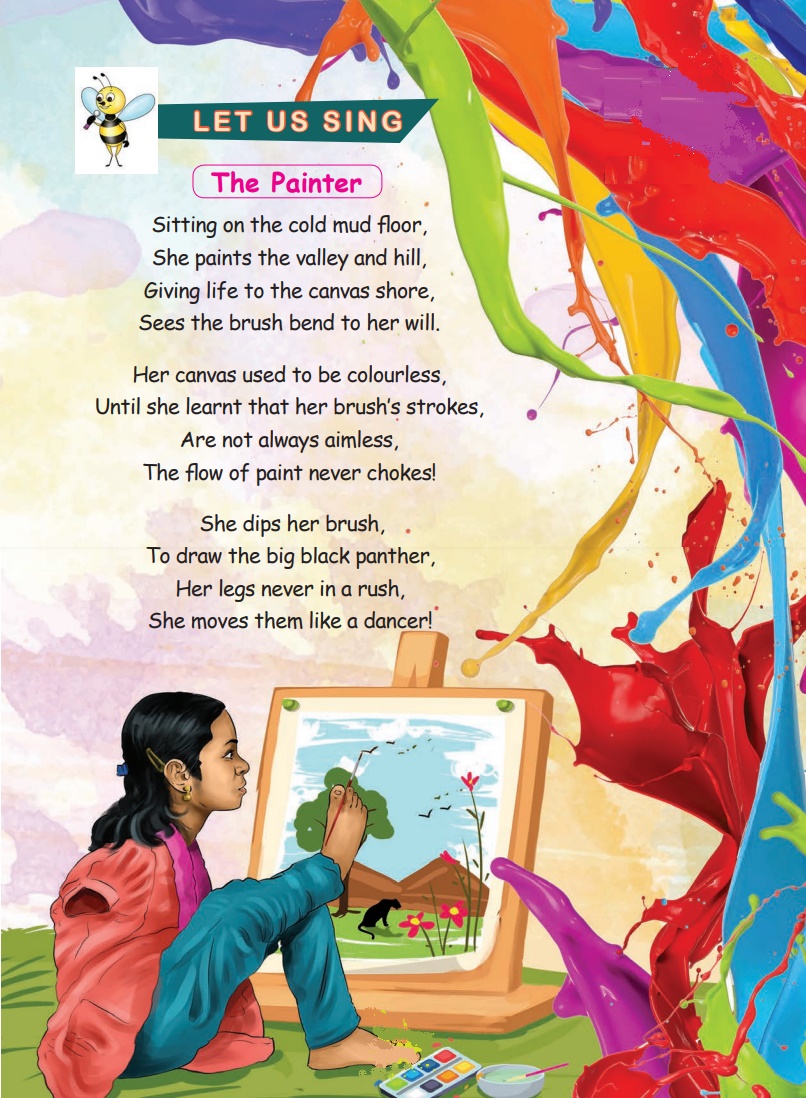
The Painter
Sitting on the cold mud floor,
She paints the valley and hill,
Giving life to the canvas shore,
Sees the brush bend to her will.
Her canvas used to be colourless,
Until she learnt that her brush’s strokes,
Are not always aimless,
The flow of paint never chokes!
She dips her brush,
To draw the big black panther,
Her legs never in a rush,
She moves them like a dancer!
Glossary
bend: shape into a curve.
strokes: gentle movement of hand.
chokes: stops.
dip: put something in liquid.
A. Name the pictures and match it with the rhyming words.
hill brush shore panther
 hill – will
hill – will
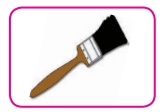 brush – rush
brush – rush
 shore – floor
shore – floor
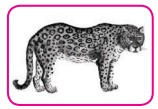 panther – dancer
panther – dancer
B. Answer the following questions.
1. What does she paint?
She paints the valley and the hill.
2. Does the brush bend to her will?
Yes, the brush bends to her will.
3. How does she move her legs?
She moves her legs like a dancer.
LET US KNOW
The rabbit has long ears.
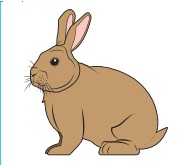
The word long tells what kind of ears the rabbit has.
Long describes the rabbit’s ears.
The house is green.

The word green tells us the colour of the house.
Green describes the house’s colour.
Kasthuri has three colourful balloons.
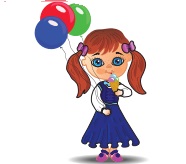
Three and colourful tells us more about noun baloon.
Three describes number and colourful describes quality.
Words that describe noun are called adjectives.
The adjectives give more detail about the noun’s size,
shape, colour and count.
A) Match the adjective with the appropriate picture.
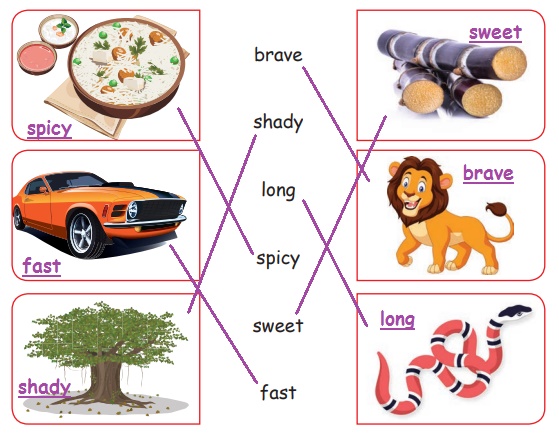
B) Use the picture and the words to write the adjective.
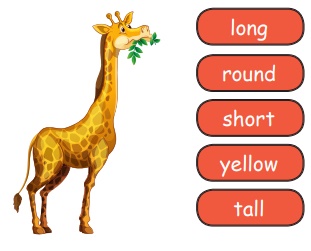
( long, round, short, yellow, tall )
1. The giraffe is tall.
2. Its neck is long.
3. Its eyes are round.
4. Its skin is yellow.
5. Its tail is short.
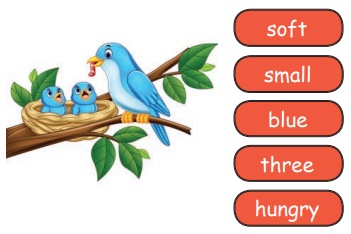
( soft, small, blue, three, hungry )
1. There are three birds.
2. The bird’s feather is very soft.
3. The colour of the birds is blue.
4. It is small in size.
5. The babies are hungry.
C. Use adjectives you think for each of these words. You can write more than one adjectives.
( clever, stormy, beautiful, dusty, good, hot, bright, cloudless, honest, lovely, fat, tall )
(Clever, stormy, beautiful, dusty, good, hot, bright, cloudless, honest, lovely, fat, tall )
1. a clever boy.
2. a stormy wind.
3. a beautiful flower.
4. a good friend.
5. a bright sun.
D) Match each sentence to the correct picture by writing the number in the box.
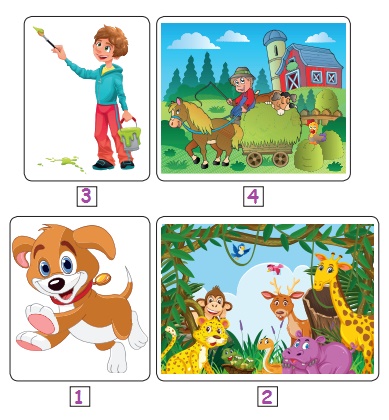
1. A brown and white puppy is having fun.
2. Wild animals are in the thick forest.
3. A cute boy is painting with green colour.
4. A naughty boy is riding horse with his sleepy dog.
LET US LISTEN
Sometimes harmony can be disrupted by the simplest things like the breaking of your lead.
Introducing DelGuard, a cleverly designed unbreakable mechanical pencil from the visionaries at Zebra pen.
DelGuard features a patented double spring mechanism that absorbs the pressure no matter how you hold it or how hard you press.
With strength comes confidence and peace of mind.
Find zen in your pen, Zebra pen.
Listen to the audio and tick (✔) true or false.
1. It is a breakable pencil. True/False✔
2. It has double spring mechanism. True✔/False
3. It absorbs the pressure. True✔/False
4. You can’t hold the pencil hard. True/False✔
5. It gives confident and peace of mind. True✔/False
Note to the teacher: Scan the QR code to listen to the audio. Let the children listen to the audio and answer the question. The listening passage is given at the end.
LET US SPEAK
Borrowing a book from public Library.
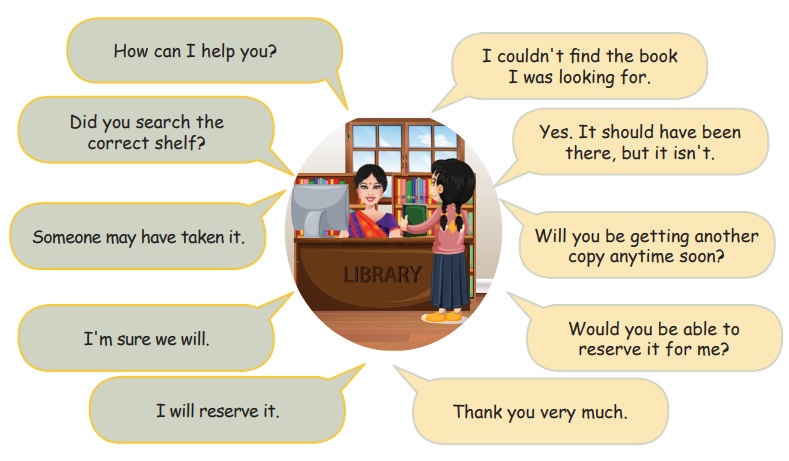
How can I help you?
I couldn’t find the book I was looking for.
Did you search the correct shelf?
Yes. It should have been there, but it isn’t.
Someone may have taken it.
Will you be getting another copy anytime soon?
I’m sure we will.
Would you be able to reserve it for me?
I will reserve it.
Thank you very much.
Phrases that are useful for this situation.
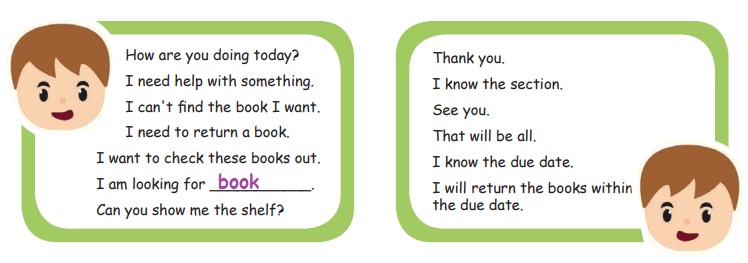
How are you doing today?
I need help with something.
I can’t find the book I want.
I need to return a book.
I want to check these books out.
I am looking for a book.
Can you show me the shelf?
Thank you.
I know the section.
See you.
That will be all.
I know the due date.
I will return the books within the due date.
Note to the teacher: Make the children know how to borrow books from the library and make them use these structure to borrow books from the class library.
LET US READ
The Wooden Toy
Once there was a village circled by mountains and many big trees. It was the home to many wild animals, especially wild dogs. They used to hunt not only the animals in the forest but, also the domestic animals in the village. This affected the farmer who lived near the edge of the forest with his son the most.
Mugund was the son of the farmer. He was good at creating many things. Every day he went into the forest to collect dry wood. He used to make dolls using the dry wood. Mugund’s art was very famous in the town. Children used to play with his dolls, mostly known as marapachi bommai.
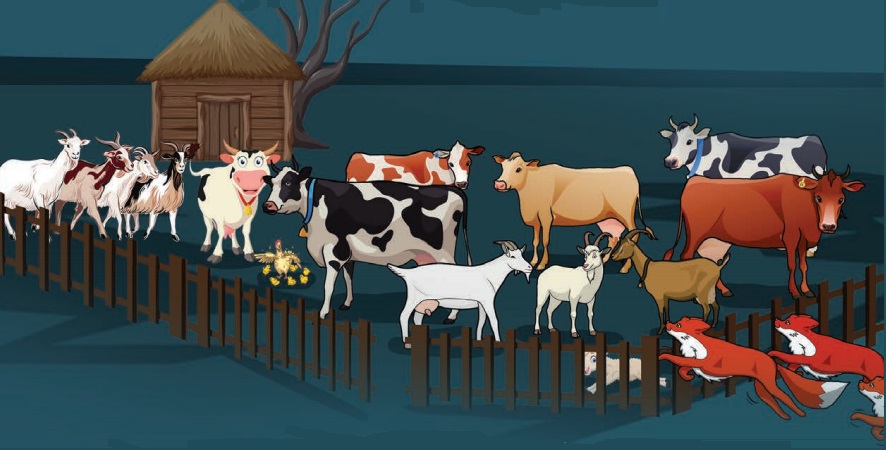
Long ago, the wild animals hunted Mugund’s mother. That incident made Mugund hate wild animals. In memory of his mother, he carved a wooden statue of his mother and prayed every day. One night, he woke to hear his mother’s words, “Do your part in eradicating the use of plastics through your art because plastic is a great risk to the environment.”
So, he started selling wooden toys at a cheap rate. He was also clever at making handicrafts. He learnt the art from his grandfather. In the beginning, he made dolls for children, using dry wood. Then, he was making statues of any photo that was show to him.
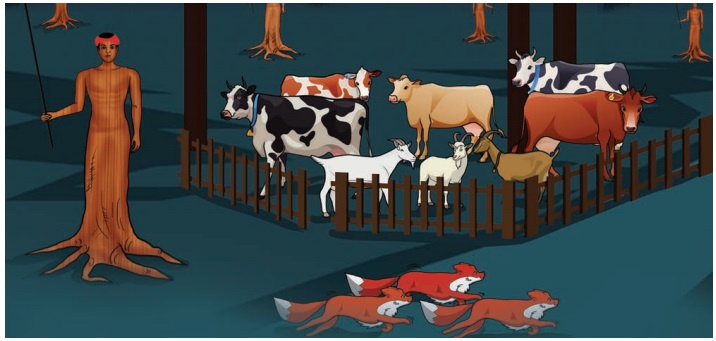
His father owned nothing but a flock of sheep and a piece of land. Also, he worked hard to keep the farm running. He was rearing some animals like goat, cow and hen. His father took all the cattle to pasture every day. When he returned home, he would always count all the animals. One day, when his father returned, he saw that some animals were missing. His father was unable to sleep because the losses of the animals kept increasing. Mohan was worried about his father. He had to do something.
He had an idea. He made a wooden drum because the massive noise from the drum would help his father to drive out the wild animals. Mugund’s father was happy because the drum threatened the animals. But, the animals came as soon as someone stopped drumming. His father couldnot be awake all night. Soon, the wild animals started attacking only at night. The restlessness and worry made the father ill.
The next day, Mugund went into the forest to find a hollow log of cedar. But, he could not find it. His friend told him to cut the raw wood. But, he refused.
Think: why it is a good decision not to cut and use the living tree.
Answer: A tree takes many years to grow. If we cut a living tree we cannot replace the loss with another tree. It will take years and years for the tree to grow. So we should always use the wood of fallen trees, not that of a living tree.
Mugund felt that his mother was still living in each tree. At last, they found some wood and brought it home. Mugund went to bed a little early. His father was beating the drums to drive all the animals away.
Suddenly the sounds of the drum stopped. Mugund’s father was tired, and he slept. Nearly twenty-five animals got attacked that night. Then, Mugund thought of designing some wooden tigers and some wooden people to place on the farm. So, the animals would be afraid as the people were still awake.
From that day onwards, the farmer and his son had a good sleep. Most of the landowners ordered wooden animals from Mugund. They wanted to save their crops and farms.
Soon, Mugund started selling toys to all corners of the land. This led to a demand for wooden dolls over plastic ones. He was happy that he was able to take part in saving the world through his art.
A. Choose the best answer.
1. Mugund made_____________using the dry woods.
a. pots
b. dolls
c. cups
d. deer
Answer: b. dolls
2. In memory of his mother, he carved _____________ statue.
a. golden
b. sliver
c. wooden
d. brass
Answer: c. wooden
3. _____________ is a great risk to the environment.
a. paper
b. cotton cloth
c. plastic
d. wood
Answer: c. plastic
4. Mugund learnt the art from his _____________.
a. father
b. mother
c. grand father
d. uncle
Answer: c. grand father
5. _____________ was helpful for his father to drive out the wild animals.
a. drum
b. wooden tiger
c. wooden doll
d. clay doll
Answer: a. drum
B. Write True or false.
1. Mugund loved wild animals. (False)
2. Mugund did not cut the raw wood. (True)
3. He started selling wooden toys at a high price. (False)
C. Answer the following questions.
1. How did Mugund’s mother die?
Mugund’s mother was killed by wild animals.
2. What did his mother say in his dream?
Mugund’s mother told him to eradicate the use of plastics.
3. What incident made Mugund make a wooden drum?
The wild animals continued to kill the animals of Mugund’s father. This incident made Mugund to make a wooden drum.
4. Why was his father unable to sleep?
A large number of animals in his father’s farm were killed by wild animals. So he was unable to sleep.
5. Which problem do you think you can solve with art? How?
Pollution by plastics can be solved with art. We can replace plastic toys with wooden toys.
LET US READ ALOUD
A. Read the passage 3 times and colour the trees for each time.
Trees help us in many ways. The colour green is calming and heals your worries. By planting and caring for trees, we help improve our surroundings, as they give fresh air. When air is dirty the people of Delhi suffered a lot. But people of Madhubani district in Bihar have shown how art can be used to make our air clean. So that people made paintings on trees to stop people from cutting the trees.
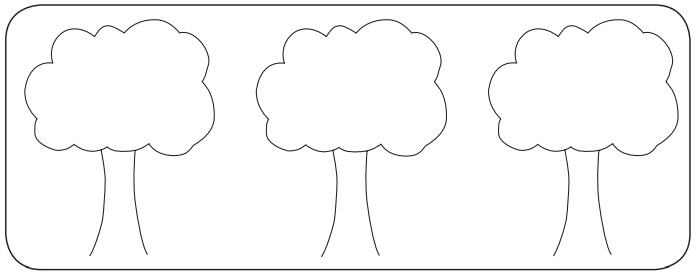
1. Bihar people saved trees making by painting.

2. What is the main idea of the story?
Prevention of deforestation.
LET US WRITE
Let us learn to write a paragraph.
Step 1 : Write a sentence about the topic.
Step 2: Write fun detail about the topic.
Step 3: Write fun detail about the topic.
Step 4: Write fun detail about the topic.
Step 5: Write a ending sentence with your feeling about the topic
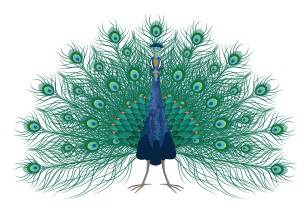
Peacock is a beautiful bird.
It has long colorful feathers.
The male bird dances beautifully.
Peacock is our national bird.
I like Peacock as it has colourful feathers..
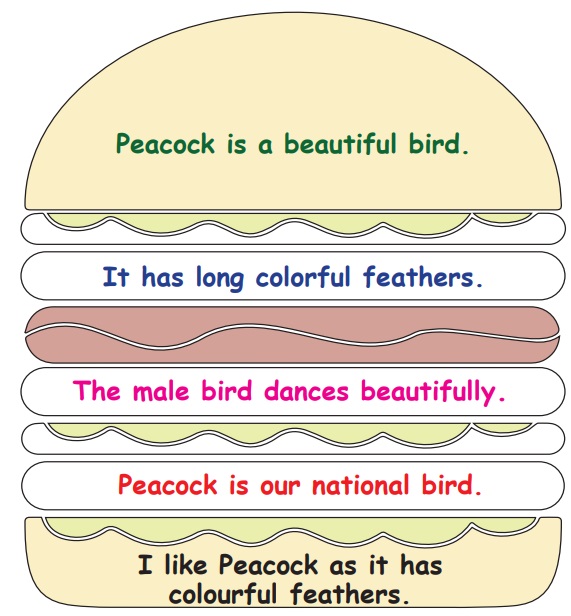
Do you want to try to write your own paragraph now?
Write a paragraph on Cow.
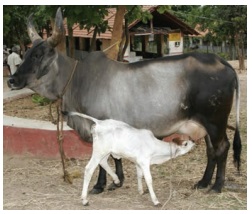
1. The cow is a tame animal.
2. It eats grass and straw.
3. It gives us milk.
4. The milk is a good food for babies.
5. Many people worship the cow as God.
Write a paragraph on Monkey.
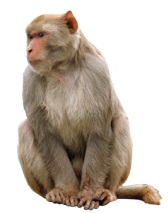
1. The monkey looks like human beings.
2. It is full of mischief.
3. It climbs up the tree easily.
4. It jumps from branch to branch.
5. The monkey has a long tail but some monkeys are without tails.
Write a paragraph on Palm tree.
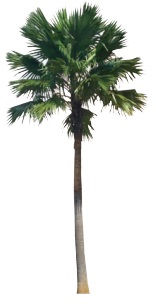
1. The palm tree is a tall tree.
2. It grows in hot, dry places.
3. We eat the fruit of the tree.
4. The palm tree gives us sweet juice called padaneer.
5. Poor people use parts of this tree to build their huts.
I Can Do
1. Choose the correct option.
1. We ________ yarn to make sarees.
a. weave
b. water
c. knead
Answer: a. weave
2. The plants ________ because of the wind.
a. grow
b. bend
c. chokes
Answer: b. bend
2. Match the words with similar meaning.
truck – subway
underground – lorry
tap – wallet
purse – faucet
Answer:
truck – lorry
underground – subway
tap – faucet
purse – wallet
3. Write the words with same meaning.

Torch Flashlight
Sink Wash Basin
Flat Apartment
4. Recite the poem The Painter with correct intonation.
5. Match the rhyming words.
strokes – floor
shore – rush
brush – chokes
Answer:
strokes – chokes
shore – floor
brush – rush
6. Describe the picture with adjectives.

( Sweet, red, round )
The apple is red.
The apple tastes sweet.
It is round in shape.
Learning Outcome
Now I can…
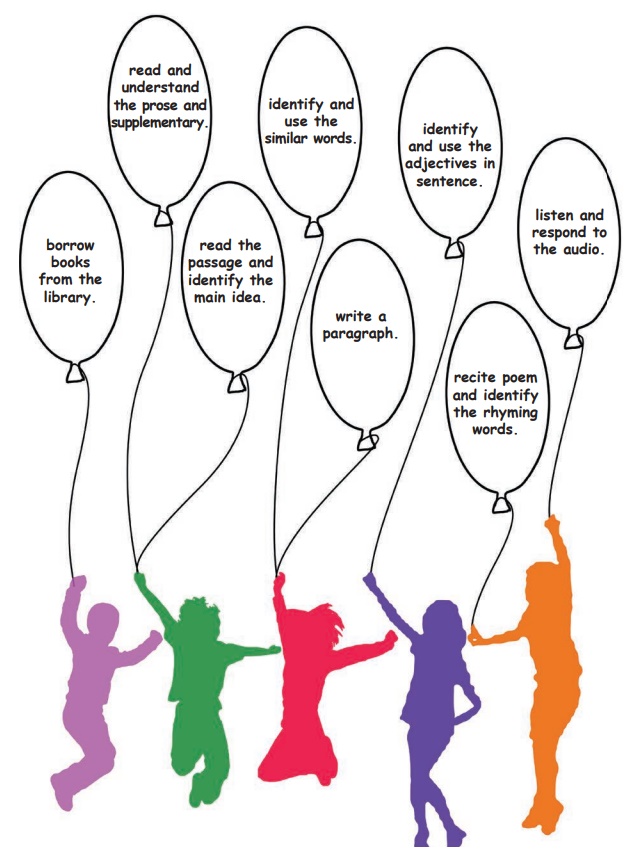
read and understand the prose and supplementary.
identify and use the similar words.
identify and use the adjectives in sentence.
listen and respond to the audio.
Borrow books from the library.
read the passage and identify the main idea.
write a paragraph.
recite poem and identify the rhyming words.
Note to the teacher: Ask children to colour the balloon when they achieve the learning outcome.

